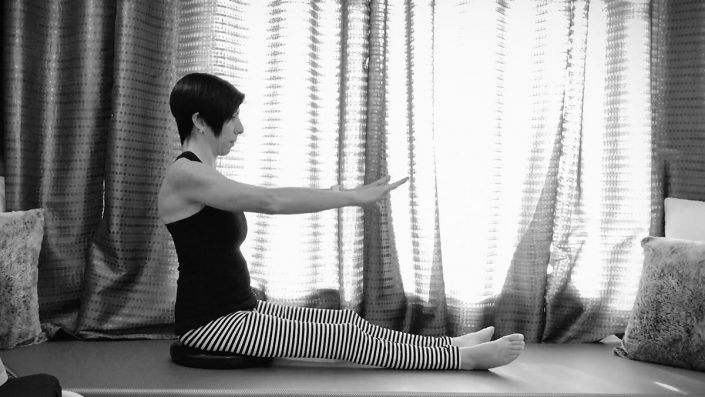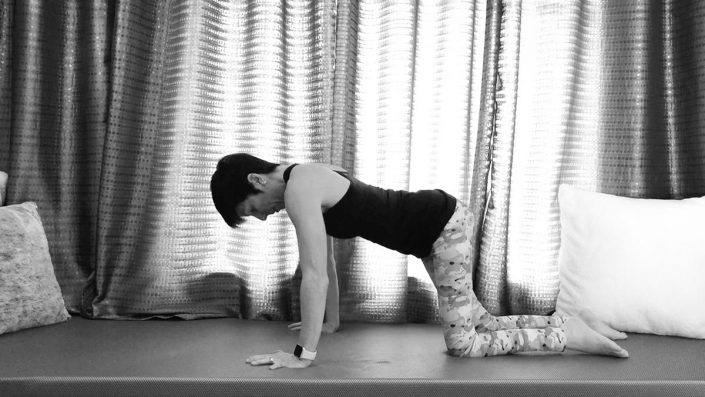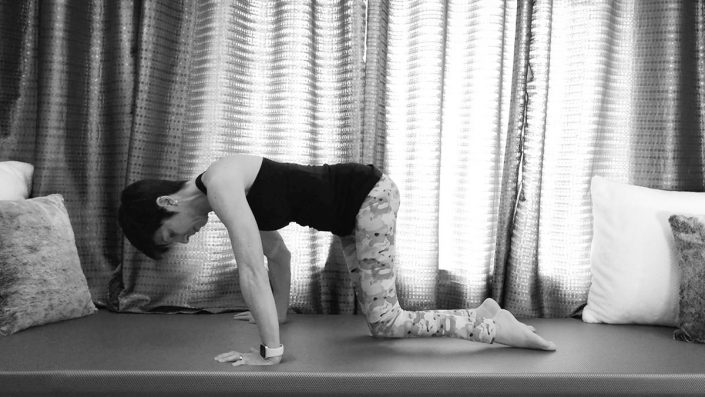Balance

Pendulum
• Muscles: trunk stabilizers (sensations may vary according to your condition): transverse abdominal, spinal extensors, lumbar spine, square of lumbar vertebrae, large dorsal vertebrae, posterior notched muscles.
• Movement: Extend both legs on the ground. Move your buttocks backwards to come and sit in the center of the stabilization pad. Try to raise your arms as high as possible while maintaining the position for as long as possible OR 1 to 2 minutes. You can vary the level of difficulty by positioning your legs differently (cross-legged or butterfly).
• Tip: If you don't have this accessory, you can also use a pillow or a thick blanket.
• Safety: Doing the exercise with assistance for the first time will help you assess your limits of movement.
• Movement: Extend both legs on the ground. Move your buttocks backwards to come and sit in the center of the stabilization pad. Try to raise your arms as high as possible while maintaining the position for as long as possible OR 1 to 2 minutes. You can vary the level of difficulty by positioning your legs differently (cross-legged or butterfly).
• Tip: If you don't have this accessory, you can also use a pillow or a thick blanket.
• Safety: Doing the exercise with assistance for the first time will help you assess your limits of movement.

Crawling
• Muscles: Anterior serratus and small pectoral, trunk stabilizers: abdominal (if there is a sensation) and back muscles (especially if the abdominal muscles cannot provide contraction)
• Start: Place yourself in crawling position. Arms stretched, hands at shoulder width and hands under the shoulders. Push lightly into the ground to keep the shoulder blades wide.
• Movement: Put the weight on the right hand, lift the left knee and try to move it slightly with the help of the muscles of the back and abdominals. Move the right hand forward and repeat the sequence.
• Tip: Always think of pushing into the ground to keep a good shoulder position. Focus on taking small steps in the first attempts.
PRE-REQUIRED: Successful completion of the "knee lift" exercise before tamping it down.
• Safety: Protect your knees by performing the exercise on a very thick mat OR use volleyball knees (or equivalent). This protection will reduce the tension on your joints.
• Start: Place yourself in crawling position. Arms stretched, hands at shoulder width and hands under the shoulders. Push lightly into the ground to keep the shoulder blades wide.
• Movement: Put the weight on the right hand, lift the left knee and try to move it slightly with the help of the muscles of the back and abdominals. Move the right hand forward and repeat the sequence.
• Tip: Always think of pushing into the ground to keep a good shoulder position. Focus on taking small steps in the first attempts.
PRE-REQUIRED: Successful completion of the "knee lift" exercise before tamping it down.
• Safety: Protect your knees by performing the exercise on a very thick mat OR use volleyball knees (or equivalent). This protection will reduce the tension on your joints.

Knee lift
• Muscles: Anterior serratus and small pectoral, trunk stabilizers: abdominal (if there is a sensation) and back muscles (especially if the abdominal muscles cannot provide contraction)
• Start: Place yourself in crawling position. Arms stretched, hands at shoulder width and hands under the shoulders. Push lightly into the ground to keep the shoulder blades wide.
• Movement: Lift the left knee off the ground and descend, controlling the movement as much as possible. Repeat the same thing with the other knee.
• Tip: Always remember to push into the ground to keep shoulders in the right position.
• Safety: Protect your knees by performing the exercise on a very thick mat OR use volleyball knees (or equivalent). This protection will reduce the tension on your joints.
• Start: Place yourself in crawling position. Arms stretched, hands at shoulder width and hands under the shoulders. Push lightly into the ground to keep the shoulder blades wide.
• Movement: Lift the left knee off the ground and descend, controlling the movement as much as possible. Repeat the same thing with the other knee.
• Tip: Always remember to push into the ground to keep shoulders in the right position.
• Safety: Protect your knees by performing the exercise on a very thick mat OR use volleyball knees (or equivalent). This protection will reduce the tension on your joints.
